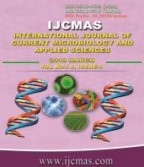


 National Academy of Agricultural Sciences (NAAS)
National Academy of Agricultural Sciences (NAAS)

|
PRINT ISSN : 2319-7692
Online ISSN : 2319-7706 Issues : 12 per year Publisher : Excellent Publishers Email : editorijcmas@gmail.com / submit@ijcmas.com Editor-in-chief: Dr.M.Prakash Index Copernicus ICV 2018: 95.39 NAAS RATING 2020: 5.38 |
A pot culture experiment was conducted at ICAR-IISWC, Ballari, Karnataka during 2016 to screen seven paddy genotypes receiving zinc fertilization for their zinc use efficiency under various moisture regimes. The experiment was laid out in a completely randomized design with two replications. At 30 days after transplanting (DAT), the plant height in M2 treatment (Saturated Soil Culture) was higher which was at par with the continuous flooding (M1) and was significantly different with the Alternate Wetting and Drying (M3). The genotype NLR 34449 produced significantly taller plants (23.8 cm) as compared to GGV 0501 (19.1 cm), which was at par with rest of the paddy genotypes. No significant differences in chlorophyll content index (CCI) were observed among different moisture regimes at vegetative stage. But, M1 and M3 treatment induced higher CCI values at tillering and panicle initiation stage, respectively. The AWD resulted in the lowest grain yield while SSC recorded the highest grain yield that was at par with the continuous flooding. Among seven salt tolerant paddy genotypes, TRY 3 was the most efficient, whereas rests of the genotypes were classified as moderately efficient. The results therefore suggested that maintaining rice plants at a saturated condition throughout the growing period helps to attain significant increase in the grain yield besides saving water under water scarce environment.
 |
 |
 |
 |
 |